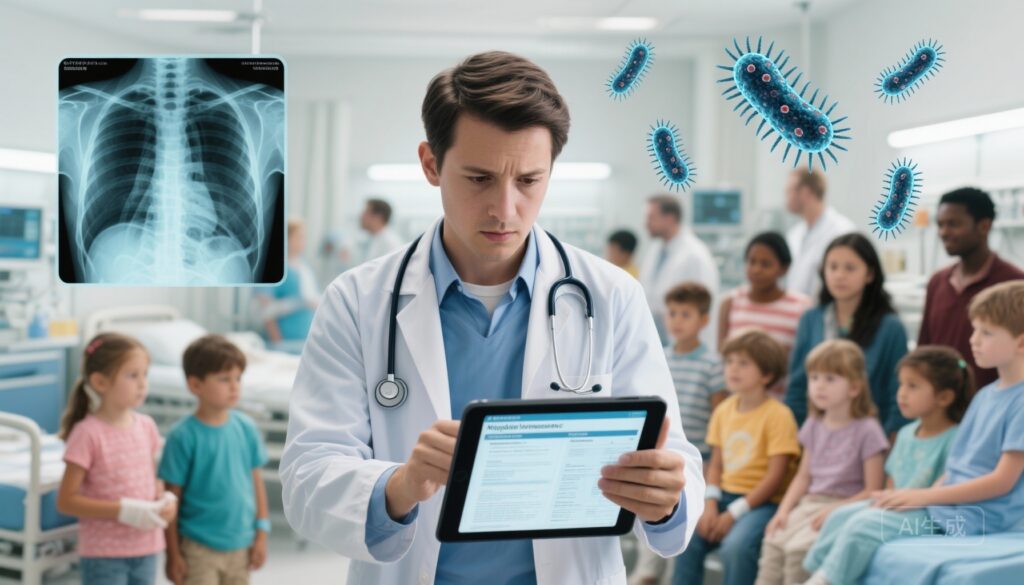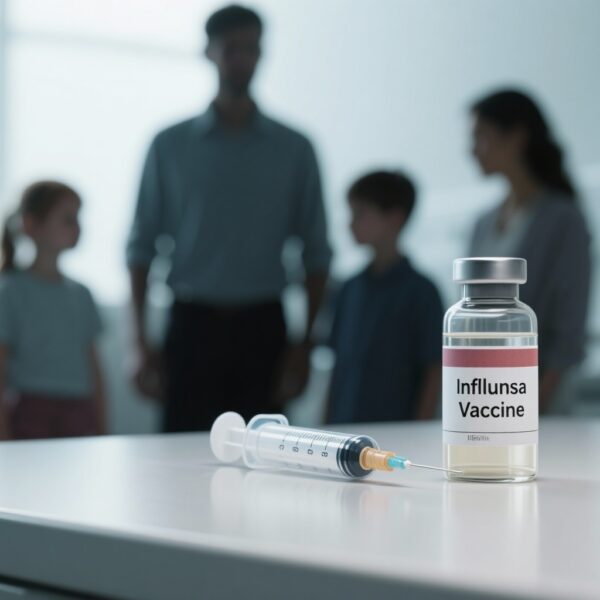Highlights
• The ORIGAMI multicentre cohort (37 French paediatric hospitals) identified 969 children hospitalised with Mycoplasma pneumoniae during the 2023–24 resurgence; PCR confirmed infection in 97%.
• Pneumonia predominated among respiratory presentations (87% of those with respiratory involvement); cutaneous manifestations occurred in 14%, with erythema multiforme present in 42% of these.
• Overall PICU admission was uncommon (6%), but independently associated with age >11 years, asthma, other comorbidities, and erythema multiforme.
• Macrolide therapy was prescribed in the vast majority of treated patients; macrolide resistance testing was limited and detected resistance in 1 of 21 samples.
Background: disease burden and clinical context
Mycoplasma pneumoniae is a common cause of community‑acquired respiratory infection in children and adolescents, often producing tracheobronchitis and atypical pneumonia and, less commonly, extrapulmonary complications (neurological, cardiac, dermatological). In many regions, non-pharmaceutical interventions during the COVID‑19 pandemic disrupted usual seasonal and multi‑year transmission cycles of respiratory pathogens, including M. pneumoniae, leading to epidemiological rebounds when measures were relaxed. The ORIGAMI study describes the clinical spectrum and severity of the 2023–24 M. pneumoniae resurgence in French children admitted to hospital.
Study design and methods
ORIGAMI is a national, multicentre observational cohort combining retrospective and prospective data collection across 37 paediatric hospitals in France between September 2023 and September 2024. Inclusion criteria were age <18 years and hospitalisation with laboratory‑confirmed M. pneumoniae infection (PCR or serology). The investigators collected demographics, clinical presentation, laboratory and radiological findings, management data (including antibiotic use), and outcomes. Logistic regression was used to identify factors independently associated with PICU admission. The trial is registered at ClinicalTrials.gov (NCT06260371).
Key findings
Population and laboratory confirmation: 969 children and adolescents were included (mean age 7.3 years, SD 4.5); sex distribution was balanced (44% female). Polymerase chain reaction (PCR) was positive in 936/969 (97%) cases, reflecting a predominantly PCR‑based diagnosis in admitted patients.
Clinical presentations
Respiratory disease dominated: among 726 patients with respiratory involvement, 628 (87%) were diagnosed with pneumonia. Cutaneous manifestations were reported in 132/969 (14%), and erythema multiforme accounted for 56/132 (42%) of dermatologic cases. Extrapulmonary manifestations, while less common, were clinically notable because of their association with more severe illness in this cohort.
Treatment patterns and antimicrobial resistance
Antibiotics were prescribed to 931 patients; macrolides were used in 884 (95% of those receiving antibiotics), with azithromycin the most prescribed agent (563/884, 64%). Macrolide resistance testing was limited: among 21 tested samples, 1 (5%) had macrolide resistance–conferring mutations detected. This low observed prevalence in tested samples should be interpreted cautiously given the very small denominator and likely selection bias of tested specimens.
Severity and outcomes
Overall, 57/969 patients (6%) required PICU admission and four patients (<1%) died. Independent factors associated with PICU admission in adjusted models included age older than 11 years (adjusted odds ratio [aOR] 2.0; 95% CI 1.1–3.6; p=0.023), a history of asthma (aOR 2.2; 95% CI 1.2–4.0; p=0.0072), other underlying conditions (aOR 2.1; 95% CI 1.2–3.7; p=0.013), and the presence of erythema multiforme (aOR 3.7; 95% CI 1.6–8.8; p=0.0025).
Interpretation and clinical implications
The ORIGAMI cohort documents a substantial hospitalisation burden from M. pneumoniae during the post‑COVID resurgence in France. Although most children experienced noncritical illness, a meaningful minority required intensive care, and several patient characteristics identified higher risk. These findings have several practical implications for clinicians, hospital systems, and public health practitioners.
1. Shifting epidemiology and its consequences
Prolonged disruption of pathogen circulation during the pandemic likely resulted in an expanded susceptible population and atypical outbreak timing. Clinicians should anticipate and recognise atypical seasonal patterns for M. pneumoniae and other respiratory agents as non-pharmaceutical interventions are modified or removed.
2. Risk stratification
Older children (>11 years), patients with asthma or other comorbidities, and those with erythema multiforme appear at elevated risk for PICU admission. The strong association with erythema multiforme emphasizes that certain extrapulmonary manifestations may herald more severe systemic disease and warrants heightened monitoring and early escalation of care when present.
3. Antimicrobial stewardship and resistance surveillance
Empiric macrolide use was near‑universal in this hospitalised cohort. Although only one resistant sample was detected among the few tested, macrolide resistance prevalence varies substantially by geography (notably high in East Asia). Limited testing in ORIGAMI highlights a critical gap: systematic resistance surveillance is required to guide empiric therapy and stewardship. Where regional resistance is high, alternatives (doxycycline for children ≥8 years, or judicious use of fluoroquinolones when warranted and risks addressed) should be considered; local guidelines must balance efficacy, safety, and resistance patterns.
4. Diagnostics
High PCR positivity in ORIGAMI confirms PCR as a sensitive diagnostic modality for respiratory M. pneumoniae. Rapid molecular testing capable of detecting macrolide resistance mutations (23S rRNA) would be clinically valuable for managing severe cases and for surveillance, but such testing is not yet uniformly available.
Expert commentary and mechanistic considerations
Mycoplasma pneumoniae pathogenesis involves direct cytotoxic effects and immune‑mediated processes, which may explain the occurrence of extrapulmonary manifestations such as erythema multiforme and neurologic complications. The association between erythema multiforme and PICU admission in ORIGAMI supports a model where immune dysregulation contributes to severity. From a guideline perspective, early recognition and supportive care remain cornerstones; adjunctive therapies (for instance, immunomodulation) may have a role in selected immune‑mediated complications, but high‑quality evidence is limited.
Limitations and generalisability
ORIGAMI focused on hospitalised children, so findings do not inform the full community disease spectrum. The mixed retrospective–prospective design and heterogeneous testing strategies across sites may introduce selection bias. Macrolide resistance testing was performed in a small subset, limiting conclusions about true resistance prevalence in France during this resurgence. Finally, data on long‑term outcomes and functional sequelae were not reported.
Clinical and research recommendations
• Implement and expand routine molecular diagnostics (PCR) for suspected M. pneumoniae in hospitalised children and incorporate assays for macrolide resistance where possible.
• Enhance antimicrobial stewardship by aligning empiric therapy with local resistance data and by re-evaluating macrolide use when resistance is documented.
• Prioritise early recognition of extrapulmonary signs, particularly erythema multiforme, as potential red flags for severe disease and consider early specialist involvement and close monitoring.
• Strengthen national and international surveillance to capture incidence, age distribution, severity, and resistance trends across care settings to inform public health responses and guidelines.
• Research priorities should include pathophysiology of M. pneumoniae–associated severe disease, prospective studies to derive and validate clinical risk scores for severe outcome prediction, and trials assessing optimal antimicrobial strategies in regions with varying resistance levels.
Conclusion
The ORIGAMI study documents a notable paediatric hospitalisation burden during the 2023–24 Mycoplasma pneumoniae resurgence in France and identifies older age, asthma, other comorbidity, and erythema multiforme as independent predictors of PICU admission. While severe outcomes were uncommon, the findings underscore the need for vigilant clinical assessment, improved diagnostic and resistance-testing capacity, antimicrobial stewardship adapted to local resistance, and robust surveillance to prepare for future epidemics.
Funding and registry
Funding: Association Clinique et Thérapeutique Infantile du Val de Marne (ACTIV). ClinicalTrials.gov registration: NCT06260371.
References
1. Chosidow A, Maakaroun‑Vermesse Z, Ok V, et al.; ORIGAMI Study Group. Post‑COVID‑19 resurgence of Mycoplasma pneumoniae infections in French children (ORIGAMI): a retrospective and prospective multicentre cohort study. Lancet Infect Dis. 2025 Nov 19:S1473‑3099(25)00598‑5. doi: 10.1016/S1473‑3099(25)00598‑5. [Epub ahead of print]
2. Waites KB, Balish MF, Atkinson TP. Mycoplasma pneumoniae: clinical features and pathogenesis. Clin Microbiol Rev. 2017 Jul;30(3):747–809. doi:10.1128/CMR.00028‑16.
3. Centers for Disease Control and Prevention. Mycoplasma pneumoniae. CDC. https://www.cdc.gov/mycoplasma/index.html. Accessed November 2025.
Author note
This article synthesises the ORIGAMI study findings and places them into clinical and public health context for clinicians and health policy stakeholders. Practical recommendations emphasize diagnostics, stewardship, and surveillance while acknowledging data limitations.


